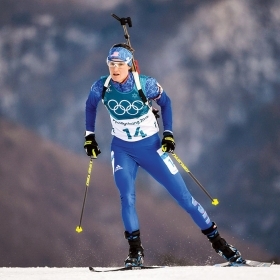Photo by Richard Howard
Taylor Hood ’18 first picked up a sword to avoid going to Pilates class. It was the summer before seventh grade, and she had tried a few sports, but none really clicked. So her parents made her do Pilates at the YMCA, where she happened to see a poster advertising a fencing class. And her life hasn’t been the same since.
Not a lot of people take up the sword, and if “fencing” makes you think of something that separates you from your neighbors or those guys fighting over rocks in The Princess Bride, you wouldn’t be alone. In fact, Hood’s father showed her a James Bond fencing scene when she first started. But it wasn’t the glamour of the sport that drew her in. “There’s a lot of complexity in fencing,” Hood says. “It’s a sport where I was physically challenging myself to get stronger, but it was also a mental challenge just to think through how you have to adjust to match each bout, because all fencers are different.”
Fencing requires not only fast footwork, but quick thinking, as well. In collegiate play, each fencing bout lasts just three minutes or five touches—whichever comes first. There are three different types of weapons: épée, foil, and sabre. For foil, Hood’s weapon of choice, a touch can only be scored with the tip of the blade made on the opponent’s chest.
Each team puts forth three athletes per weapon, and each one faces off against each of the three fencers from the opposing team, for a total of nine bouts per weapon, and 27 bouts overall. The team that is victorious in 14 bouts or more is the winner. “My teammates will actively be saying, ‘Don’t do that, you need to try this,’ so I’m still thinking through what to do, but I have a great number of team members who are actively helping me in the bout,” Hood says.
That coaching element really appeals to Hood. This year, she served as head captain on the team, and she was foil squad captain her junior year. But nearly 10 years of competitive fencing have taken their toll physically, and she won’t be actively competing further. But she plans to help coach fencing back at her home club in Lexington, Ky., after she graduates. “It’s so rewarding to spread something you love to new people,” Hood says.
Coaching is just part of her plans, however. Hood hopes to take a gap year before attending medical school, with a possible focus on neurology. All the mental challenges she’s faced fencing spurred an interest in the workings of the brain. “I’m fascinated with how the brain connects to make it so that if someone comes to a certain area, my body automatically moves to block,” she says.
Hood finished the regular season with a 40–24 record overall, helping the fencing team to a 20-9 record, their best since 2010–11. She’s competed in the NCAA Northeast regionals all four years, and although these final bouts have been bittersweet, she wouldn’t have it any other way. “[Fencing has] been such a crucial part of my life,” Hood says. “It’s made me who I am today.”
Take that, Pilates.





We ask that those who engage in Wellesley magazine's online community act with honesty, integrity, and respect. (Remember the honor code, alums?) We reserve the right to remove comments by impersonators or comments that are not civil and relevant to the subject at hand. By posting here, you are permitting Wellesley magazine to edit and republish your comment in all media. Please remember that all posts are public.